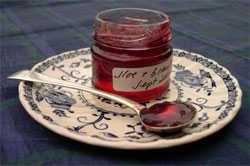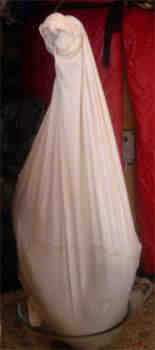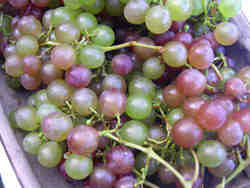Sloe and Bramley Apple Jelly Recipe
Posted by Fiona Nevile in Jam Jelly and Preserves | 110 comments
Tiny pot of sloe and apple jelly
This recipe makes a good raunchy jelly to eat with red meat, game and strong cheese. It’s also great as a sauce base for red meat, such as lamb chops. Danny usually adds a generous dollop to his pheasant casserole and dinky individual game pies, rather than adding a slug of port or sloe gin. As Sloe and Bramley Jelly has a good, strong depth of flavour it is definitely worth making a decent batch for your store cupboard. We use a bit more sugar than the usual 1pt/1lb ratio with this jelly and this seems to work well as we always use cooking apples.
Ingredients:
- 1 1/2 pounds/700g sloes, washed
- 1 1/2 pounds/700g of bramley cooking apples (ideal) or any other cooking apples. We use windfalls as they won’t keep.
- Sugar (1 UK pint/750ml/2 1/2 cups of strained juice to 1 1/2 pounds/700g of white granulated sugar, if using cooking apples. 1 pint/750ml/2 1/2 cups of strained juice to 1 pound/454g if using sweet eating apples).
Method:
- Wash the apples, cut out bad bits and chop roughly. There is no need to peel or core the apples.
Place sloes and apples in a large deep heavy bottomed saucepan, or preserving pan. - Add water to cover ½ of the fruit. Bring slowly to the boil and simmer very gently until all the fruit is soft and squishy. (This can take anything from 20 minutes to an hour, depending on how ripe the fruit is.)
- Pour the cooked fruit through sterilised muslin (how do I sterilise muslin? See tips and tricks below). The muslin is often referred to as a “jelly bag”. We use tall buckets to catch the drips from the jelly bags. Rather than hang the bags (conventional method-between two stools) I find it easier to line a large plastic sieve with the muslin. This clips neatly onto the top of a clean bucket. The sieve is covered with a clean tea cloth to protect against flies.
- Leave the jelly bag to drip overnight (or about 12 hours).
- Measure the juice the next day.
- Pour the juice into a deep heavy bottomed saucepan and add 1½ lb/700g of white granulated sugar for each 1pt/570ml of juice.
Heat the juice and sugar gently stirring from time to time, so as to make sure that that all the sugar has dissolved before bringing the liquid slowly to the boil. - Continue to boil for about 10 minutes before testing for a set. This is called a rolling boil. (What is testing for a set? See tips and tricks below).
- Tossing in a nugget of butter towards the end will reduce the frothing that can occur.
When jelly has reached setting point pour into warm sterilised jars using a funnel and ladle. (How do I sterilise jars? See tips and tricks below). - Cover immediately with plastic lined screw top lids or waxed disks and cellophane tops secured with a rubber band.
- Label when cold and store in a cool, dark place. Away from damp.
Tips and tricks:
- What is a jelly bag?
A jelly bag is traditionally a piece of muslin but it can be cheesecloth, an old thin tea cloth or even a pillowcase. The piece needs to be about 18 inches square. When your fruit is cooked and ready to be put in the jelly bag, lay your cloth over a large bowl. Pour the fruit into the centre of the cloth and tie the four corners together so that they can be slung on a stick to drip over the bowl. Traditionally a stool is turned upside down, the stick is rested on the wood between the legs and the jelly bag hangs over the bowl. We experimented and now line a sieve with muslin, place it over a bucket and cover the lot with clean tea cloths (against the flies). - How do I sterilise muslin/the jelly bag?
Iron the clean jelly bag with a hot iron. This method will also sterilise tea cloths. - Jam “set” or “setting point”?
Getting the right set can be tricky. I have tried using a jam thermometer but find it easier to use the following method.
Before you start to make the jam, put a couple of plates in the fridge so that the warm jam can be drizzled onto a cold plate (when we make jam we often forget to return the plate to the fridge between tests, using two plates means that you have a spare cold plate). Return the plate to the fridge to cool for approx two minutes. It has set when you run your finger through it and leave a crinkly track mark. If after two minutes the cooled jam is too liquid, continue to boil the jam, testing it every few minutes until you have the right set. The jam is far more delicious if it is slightly runny. - How do I sterilise the jars?
We collect jars all year round for our jelly, chutney and jam making sessions. I try to soak off labels and store the clean jars and metal plastic coated screw-top lids in an accessible place. The sterilising method that we use is simple. Just before making the jam, I quickly wash and rinse the jars and place them upside down in a cold oven. Set the temperature to 160c/140c for fan assisted. When the oven has reached the right temperature I turn off the heat. The jars will stay warm for quite a while. I only use plastic lined lids for preserves as the all-metal lids can go rusty. I boil these for five minutes in water to sterilise them. If I use Le Parfait jars, I do the same with the rubber rings.
Leave a reply







Hi, Please can you let me know where I can buy sloes from ?????
Thanks, How would you use a fruit cheese then? That’s soooo naive isn’t it? I know you can use it with cheeses, but other than that I’m stumped, oooh it’s exciting though.
Lou x x x
Hi Lou
You can make fruit leathers and fruit cheese. Membrillo is a sort of fruit cheese.
Hi there
I am about to make some crabapple jelly again this year and wondered if you had and recipe ideas or suggestions for the fruit pulp that will get left over, it seems such a shame to bin it.
I have found a couple of chutney recipes, but I am not too sure how the jelly making process might affect the chutney.
Waste not want not and so on.
Any help or ides gratefully received
Lou
Hello Steve B
It sound as if your juice was still to thick. Quinces need a long simmer bubbles just brushing the surface intermittently with the lid on and ots of checking and adjusting. Ideally the juice is thicker than water but thinner than single cream. Danny admires you for having a go! He’d never have the patience.
My first jelly just tasted of sugar then a ‘Jelly Making Demi God’ gave me two tips. Always taste the fruit juice before adding the sugar and add a tblsp of fresh lemon juice if you think the fruit juice tastes bland. You don’t need a pint to a pound of sugar. Quince jelly will set with much less, taste as you add the sugar and when you reckon that it ‘tastes right’ bring the solution to the boil.
Well, I finally got it into jars! The juice was still very viscous, I had to use brute force to get it through the jelly bag. I wonder if I heated it up too much in the initial stages and it was starting to thicken? Anyway it looks beautiful but tastes more of sugar than anything else, I think I’ll take the advice you’ve given to Patrick and reboil it with some lemon juice. Meanwhile quince brandy making awaits!
Hi Patrick,
You could always try boiling up your too sweet jelly again and adding some lemon juice.
Quite often I taste the fruit juice as it is heating up before I add the sugar. A little fresh lemon juice (sieved) can also develop the flavour of the fruit juice and also will help with the setting if you cut down on the sugar.
Morning
Just finished the sloe gin and brambley jelly, think it maybe too sweet, possibly from all the sugar in with the sloes during Gin Flavouring – will update when cold and served! I have more left so will poss try again with about half the sugar content
Patrick
Hi Steve B
I hope that you had better luck this time. I’d love to hear how you get on. Mildred is right about the lid and very gentle simmering you also need to bring it to simmering point uite gently too.
Hi Mildred
Thanks for the suggestions!
Hi Patrick,
I would be very interested to hear what the jelly tates like!
Hi all
Going to try using my sloe gin berries with some bramleys from the market to see if I can make a decent jelly
All in the name of science!!
Wish me luck